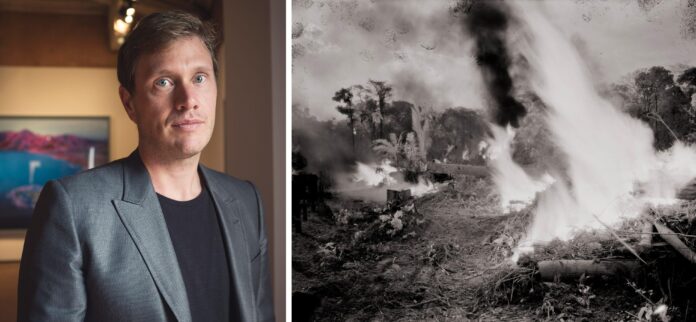The Irish-born, New York-based artist Richard Mosse makes unorthodox use of military-grade imaging technology to confront some of the most significant humanitarian crises of our time. Mosse represented Ireland at the 2013 Venice Biennale with a six-channel video installation capturing war zones in the Democratic Republic of Congo using discontinued Kodak infrared surveillance film that rendered the landscape in lurid shades of pink. In 2017, he won the Prix Pictet photography award for his disquieting panoramas of refugee camps, made with a thermal camera designed to detect body heat from 30km away and classified as a weapon under international law. Now, Mosse has turned his attention to the climate crisis in Broken Spectre, an immersive widescreen video installation on view at 180 The Strand in London and at the National Gallery of Victoria in Melbourne, Australia. The film marks the culmination of three years spent documenting the catastrophic destruction of the Amazon rainforest.
The Art Newspaper: What are you aiming to express in Broken Spectre?
Richard Mosse: It’s trying to represent something that’s ineffable, which is climate change. We could have chosen the Gulf Stream, or the polar ice caps melting, but whereas these crises are a result of our ancestors acting, the Amazon is distinct in that its deforestation only began in earnest in the 1970s when the Brazilian military regime started to build the Trans-Amazonian Highway. It’s a wilful, systematic catastrophe on a sociological level: every dry season, millions of people are going out to burn the forest across nine countries. It’s a vast intergenerational problem that’s only been around for a few decades and, according to climate scientists, we only have ten years left. This is something that we have to turn around now.
There is conventional black-and-white footage in the new film but, as in your past work, you’ve also used advanced surveillance and photographic techniques that result in vividly coloured psychedelic images. Why are you drawn to these technologies?
The points of failure of documentary photography are what interests me: where the camera fails to tell the story adequately. I’m interested in trying to find new ways of storytelling. We need to work together to help people really understand what’s at stake here with climate change. We’ve got all the data and the information, and yet it’s still not penetrating our collective brains. It’s something that’s beyond human perception, something that you can’t just put in front of the lens and get people to understand and relate to.

Richard Mosse’s video work, Broken Spectre (2022), includes images shot from a helicopter using imaging technologies that capture the extent of environmental destruction across the Amazon Courtesy of the artist, Jack Shainman Gallery, New York and carlier; gebauer, Berlin/Madrid
How have you risen to this challenge?
I’ve chosen to break it down in scale, from the macro to the micro to the human, to try and examine it from the ground up and from the sky down, but also to work on a cultural level, in terms of inter-human relations. The multi-spectral footage that we shot from a helicopter is intended to show not just the widespread scale of the [environmental] crimes we’re seeing, but also the mass organisation. There are mafia rings across the Amazon who are working for the large farmers all the way up to international economic levels. In places, I’ve tried to make a Western film; there are people on horseback herding cattle and wearing ten-gallon hats because 85% of the rainforest is being destroyed for the international trade in cheap beef and also leather for our fancy car seats. There’s also unfamiliar non-human imagery shot with UV film in the middle of the night, showing a six-inch square of the rainforest floor teeming with species, many of which we haven’t even discovered and which we now stand to lose. What we have to do is make people feel an uneasy sense of complicity, to make them feel that their own hands are dirty. And that’s particularly challenging because the Amazon is so far away from most of us.

Broken Spectre (2022 documents the impact of deforestation on the communities who live across the region © Richard Mosse
In one powerful sequence, Adneia, a woman from the Indigenous Yanomami people, challenges you with an impassioned request for support. This direct human encounter is a new departure from your previous films.
Yes, I think this is my first activist artwork. A lot of people will be very moved by Adneia’s words because she’s confronting me, and thereby confronting the viewer. It’s very uncomfortable to watch.
Broken Spectre premiered in Melbourne just before the Brazilian elections. What do you hope it will achieve?
I don’t think one video artwork will keep Bolsonaro out and, in the case of the Amazon, I’m not particularly optimistic. But I do believe in the importance of making art that addresses what’s at stake in our world, on a politically engaged level. There’s a whole spectrum of people who can work together: not just artists alone, but artists working alongside writers, scientists and politicians. I don’t believe in art that tells you what to think. I want the viewer to make up their own mind and to feel disorientated and slightly violated by the work.
You occupy a fluid territory between photo reportage and fine art. Would you describe yourself as having a foot in each camp?
I’m stuck in a no-man’s land between the two, and it’s a very lonely place. They won’t let me enter either side: I’m a sort of shadow lurking without a passport and just getting on with it. I seem to be able to somehow navigate the space between and I think that’s a space I’ve built for myself, for better or worse.
• Richard Mosse: Broken Spectre, 180 The Strand, until 18 December

























